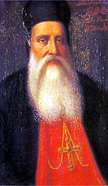Joseph Ragi El Khazen
Joseph IX Ragi El Khazen (born in 1791, Ajaltoun, Lebanon – died on 3 November 1854, Dimane, Lebanon), (or Youssef El-Khazen, Gazen, Arabic: يوسف التاسع الخازن, Latin: Iosephus Alchasen), was a former bishop of the Maronite Catholic Archeparchy of Tripoli and the 69th Maronite Patriarch of Antioch from 1845 until his death in 1854.
Joseph IX El Khazen (يوسف التاسع الخازن) | |
|---|---|
| Patriarch of Antioch | |
 | |
| Church | Maronite Church |
| See | Patriarch of Antioch |
| Elected | August 18, 1845 |
| Term ended | November 3, 1854 |
| Predecessor | Joseph Peter Hobaish |
| Successor | Paul Peter Massad |
| Orders | |
| Consecration | April 6, 1830 (Bishop) by Joseph Peter Hobaish |
| Personal details | |
| Born | 1791 Ajaltoun, Lebanon |
| Died | 3 November 1854 (aged 62–63) Dimane, Lebanon |
Life
Joseph Ragi El Khazen was born in the village of Ajaltoun, in the Keserwan District, Lebanon in 1791,[1] and he was a member of the Khazen family, which ruled the Keserwan District. The Khazen family had the privilege of nominating three Archbishops, including the one of Damascus. However, Joseph El Khazen was appointed Archbishop of the Maronite Catholic Archeparchy of Tripoli and so consecrated bishop on April 6, 1830, by the Maronite Patriarch Joseph Peter Hobaish.
When Patriarch Joseph Peter Hobaish died on May 23, 1845, Mount Lebanon was in the middle of the conflict between the Druze and Maronite communities after the so-called Double Qaimaqamate division of Lebanon. The bishops couldn't meet before August, and on August 18, 1845, they elected Joseph El Khazen as Patriarch. The election was contested by some local peasants who were supporters of another candidate, and Joseph El Khazen had to escape from Dimane to Zouk Mikael, where he took up his residence. The election was confirmed anyway by Pope Gregory XVI on January 19, 1846.[2] His human qualities and his diplomatic skills earned to him soon the sympathy and support of the whole nation Maronite. El Khazen had the support of France, managed to persuade the warring parties to lay down their arms to restore peace in Lebanon.
Joseph El Khazen initially had to face the adversities of the conflict, including the Ottoman military invasion and repression against the Maronites in North Lebanon.[3] He, who was of a mild disposition,[4] tried to ease relations with Great Britain (which supported the Druzes) and the Ottomans, so obtaining some relief for his people.[1] In 1850 he rescued some Christians during the massacre of Aleppo.
From a religious point of view, during his reign the issue of confessions ministered outside the church-buildings arose again, a use previously condemned by Rome, and again condemned by Rome on February 18, 1851.[5] Joseph El Khazen died on November 3, 1854[6] in the winter Maronite Catholic Patriarchate in Dimane, Kadisha Valley, Lebanon.[7]
See also
- List of Maronite Patriarchs
- Maronite Church
Citations
- K. Rizk (2003). "Khazen Joseph Ragi". Dictionnaire d'histoire et de géographie ecclésiastiques. 28. Paris: Letouzey et Ané. pp. 1424–1425.
- Vacant, Alfred; Mangenot, Eugene; Amann, Emile (7 September 2018). "Dictionnaire de théologie catholique : contenant l'exposé des doctrines de la théologie catholique, leurs preuves et leur histoire". Paris : Letouzey et Ané – via Internet Archive.
- "The Maronite Patriarchs". Kobayat. Retrieved 23 January 2011.
- Leeuwen, Richard (1994). Notables and Clergy in Mount Lebanon: the Khazin Sheiks and the Maronite Church. Boston: Brill Academic Publishers. p. 242. ISBN 978-90-04-09978-4.
- Dib, Pierre (2001). Histoire des Maronites: L' église maronite du XVIe siècle à nos jours, Volume 3. Librairie Orientale. pp. 234–235. ISBN 978-9953-17-005-3.
- "Patriarch Joseph IX Ragi (Youssef) El-Khazen (Gazeno)". Catholic-Hierarchy.org. David M. Cheney. Retrieved 23 January 2015.
- Dau, Butros (1984). Religious, cultural and political history of the Maronites. Lebanon. p. 726.
Sources
- Pierre Dib, v. Maronite (Eglise), https://archive.org/stream/dictionnairedet10pt1vaca#page/n59/mode/2up , Tome Dixième, première partie, Paris 1928, coll. 105–106.
- K. Rizk, Khazen Joseph Ragi, in Dictionnaire d'histoire et de géographie ecclésiastiques, 28 (2003), pp. 1424–1425.